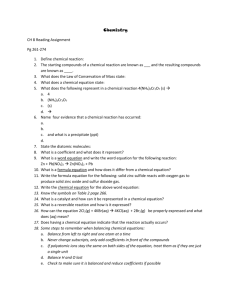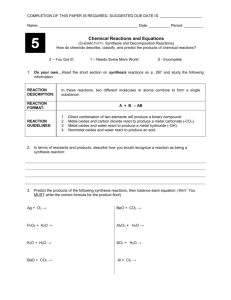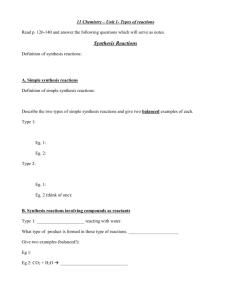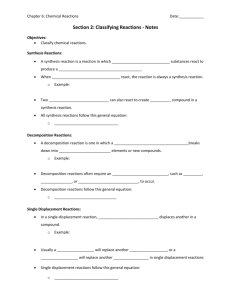Chemical Change and Reaction Types
advertisement
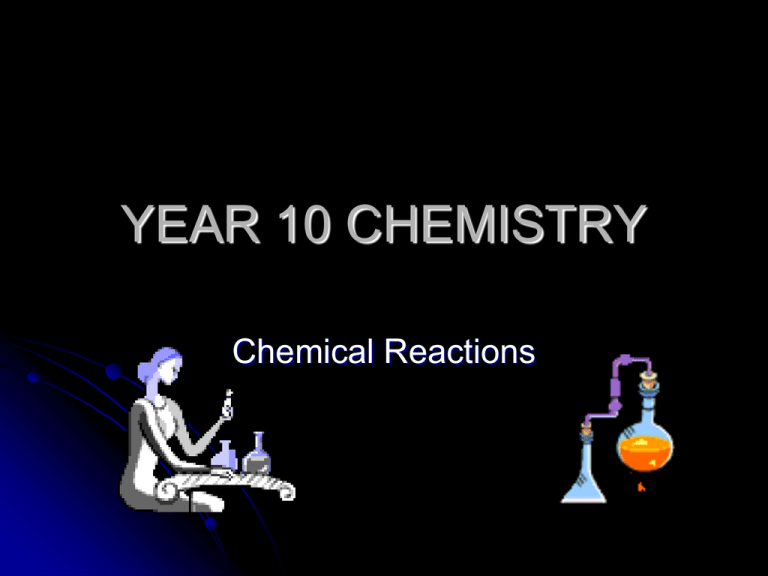
YEAR 10 CHEMISTRY Chemical Reactions Physical & Chemical Changes What is the difference between a physical and a chemical change? A physical change is one in which no new substance is formed eg ice melting A chemical change or chemical reaction has occurred if one or more new substances are formed. 3 PHYSICAL Changes shape Breaks into smaller pieces Dissolves Mixed with another substance Changes state No new substances formed CHEMICAL A permanent colour change A gas is given off Change in temperature Precipitate forms One metal is deposited on another New substances are formed Evidence of chemical changes 1. Colour change 5 2. A gas is given off 6 3. Temperature changes Endothermic reactions - absorb heat and as a result the temperature falls Demo Exothermic reactions - release heat and as a result the temperature rises Demo 7 Endothermic reaction Endothermic reaction of barium hydroxide and an ammonium salt. Mix the two solids; they react, and the products dissolve in water of hydration. The reaction feels cold. 8 Exothermic reaction Contains sodium acetate 9 Metal deposition Sometimes one metal can coat another metal. An example is an iron nail placed in a solution of copper sulfate. The result is an orange coating on the nail. The coating is copper metal. Precipitation When two solutions are mixed, sometimes a solid is formed. The solid is called a precipitate. Chemical Reactions Types of Chemical Reactions There are five types of chemical reactions we will talk about: 1. 2. 3. 4. 5. Synthesis: A + B -> AB Decomposition: AB -> A + B Precipitation: a solid forms Combustion: uses oxygen Single Displacement: A + BC -> AC + B Double Displacement: AB + CD -> AD + CB You need to be able to identify the type of reaction and predict the product(s) 13 1. SYNTHESIS • Synthesis reactions occur when two substances (generally elements) combine and form a compound. • Sometimes called combination or addition reactions. • In general: A + B AB reactant + reactant 1 product • Example: C + O2 CO2 1. SYNTHESIS Hydrogen and oxygen yields water 2H2 + O2 2H2O Magnesium plus nitrogen yields magnesium nitride 3Mg + N2 Mg3N2 Iron and sulfur yields iron(II) sulfide Fe + S FeS 15 Practice Predict the products. Write and balance the following synthesis reaction equations. • Sodium metal reacts with chlorine gas Na(s) + Cl2(g) • Solid Magnesium reacts with fluorine gas Mg(s) + F2(g) • Aluminum metal reacts with fluorine gas Al(s) + F2(g) 2. DECOMPOSITION • Decomposition reactions occur when a compound breaks up into the elements or in a few to simpler compounds • In general: AB A + B 1 Reactant Product + Product • Examples: 2H2O 2H2 + O2 2HgO 2Hg + O2 2.Decomposition Exceptions Carbonates and chlorates are special case decomposition reactions that do not go to the elements: • Carbonates (CO32-) decompose to carbon dioxide and a metal oxide Example: CaCO3 CO2 + CaO • Chlorates (ClO3-) decompose to oxygen gas and a metal chloride Example: 2Al(ClO3)3 2 AlCl3 + 9 O2 • There are other special cases, but we will not explore these Practice Predict the products. Then, write and balance the following decomposition reaction equations: • Solid Lead (IV) oxide decomposes PbO2(s) • Aluminum nitride decomposes AlN(s) Practice Identify the type of reaction for each of the following synthesis or decomposition reactions, and write the balanced equation: • N2(g) + O2(g) • BaCO3(s) • Co(s)+ S(s) • NH3(g) + H2CO3(aq) 3. PRECIPITATION Two solutions mixed together make a solid AgNO3 (aq) + NaCl (aq) 2 clear solutions reacting to form a yellow precipitate AgCl (s) + NaNO3 (aq) AgCl precipitate 21 4. COMBUSTION Uses oxygen, happens quickly and produces heat and light. 22 Hydrocarbon combustion reactions What do you notice about these combustion reactions? Balance: 23 5. NEUTRALISATION Acid + base reaction Produces salt and water. Example: HCl(aq) + NaOH(aq) NaCl (aq) + H2O (l) 24 6. DISPLACEMENT One metal deposits on another. A metal solution reacts to become the pure solid metal. Example: Zn(s) + CuSO4(aq) ZnSO4(aq) + Cu(s) Amanda Clarke 2007 6. Single Displacement Fe(s) + CuSO4(aq) FeSO4(aq) + Cu(s) Example: When an iron nail placed in a solution of copper sulfate the result is an orange coating on the nail. The coating is copper metal. Classify the following reactions: C3H8(l) + 5O2 Combustion HNO3(aq) + LiOH(aq) Neutralisation CuSO4 + 2NaOH(aq) Precipitation 2Na(s) + Cu(NO3)2 Displacement KMnO4(s) Decomposition N2(g) + O2(g) Combination 3CO2(g) + 4H2O(l) LiNO3 (aq) + H2O (l) Na2SO4(aq) + Cu(OH)2(s) 2NaNO3 (aq) + Cu(s) KMnO2(s) + O2(g) 2NO(g) 27 Symbols used in Chemical reactions (s) solid (l) liquid (g) gas (aq) aqueous (a solution: means the substance is dissolved in water) Amanda Clarke 2007 Classify the following reactions: C3H8(l) + 5O2 Combustion HNO3(aq) + LiOH(aq) Neutralisation CuSO4 + 2NaOH(aq) Precipitation 2Na(s) + Cu(NO3)2 Displacement KMnO4(s) Decomposition N2(g) + O2(g) Combination 3CO2(g) + 4H2O(l) LiNO3 (aq) + H2O (l) Na2SO4(aq) + Cu(OH)2(s) 2NaNO3 (aq) + Cu(s) KMnO2(s) + O2(g) 2NO(g) Amanda Clarke 2007 Reactants and products Write an equation that shows this experiment. Indicate the reactants Indicate the products 30 Word and chemical equations Word equation Hydrogen + oxygen Chemical equation 2H2 + O2 water 2H2O 31 Symbols used in Chemical equations (s) solid (l) liquid (g) gas (aq) aqueous - the substance is dissolved in water (solution) a gas is given off ↓ a precipitate forms (a solid in a solution) 32 When balancing an equation focus on just ONE element at a time. Don't try and do it all in your head. Choose an element, balance it and then in the next step worry about how your attempt at balancing has effected other elements. 33 Balancing chemical equations Na + H2O NaOH + H2 This 'equation' is NOT balanced! Only place numbers at the front. 34

